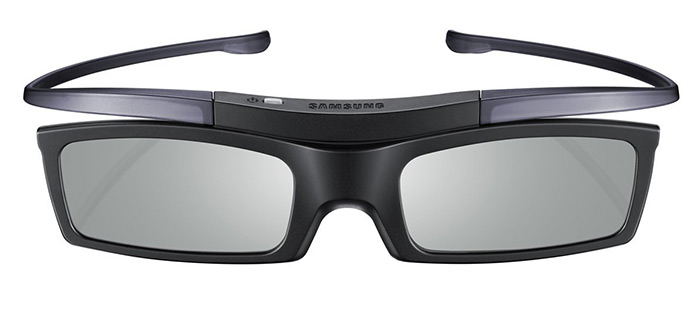Dear Big Picture Big Sound,
I've had a 3D TV (Panasonic TC-P65VT60) for a couple of years, but don't use the 3D feature that much. One reason is that the TV only came with two pairs of 3D glasses and there are 4 people in the family. I'm interested in picking up a few more pairs of glasses so we could all watch 3D together. Looking around online, the original Panasonic glasses are hard to find, and are pretty expensive (over $100/pair). But Samsung makes some cheaper ones (under $30/pair) that look pretty good.
Can I use the Samsung 3D glasses with my Panasonic 3D TV? Will there be any drawbacks in doing so?
Thanks,
-Joe
Hello, Joe,
The answer to that question is, "it depends." It depends on the specific glasses and the model and brand of TV you are using. When 3D TVs were new, every manufacturer had their own way of synchronizing their TVs with the 3D glasses in order to create a 3D image. Synchronization is critical because it assures that the left eye sees the left eye image and the right eye sees the right eye image, and this gives you the illusion of stereoscopic 3D.
This lack of a universal standard led to some confusion, including a ridiculous article that stated that you could use Samsung 3D glasses with Panasonic TVs if you wore them upside down. The real issue there was that the glasses were synchronized to the wrong TV which led to them be one frame off: the left eye was getting the right eye signal, and vice versa. But even if you wore the glasses upside down, a Panasonic 3D TV from 2010 or 2011 could not activate a pair of Samsung 3D glasses, nor could a Samsung TV from 2010 or 2011 turn on a pair of Panasonic 3D glasses.
In 2012, things got better with the adoption of the Full HD 3D RF standard. With this standard, glasses are synchronized with the 3D TV using Bluetooth which is a form of RF (Radio Frequency) instead of the old method of IR (Infrared) synchronization. RF is inherently a better way to synchronize the signal because it doesn't lose synch if you turn your head, leave the room for a moment or move a little further away from the TV. Also, by making the communication adhere to a standard, it is possible to use one brand's 3D glasses with another brand's 3D TV. Samsung, in particular, makes some very affordable active 3D glasses (under $30/pair, as you mentioned), while some other manufacturers charge $50 or even $100 for a pair.
Here are a couple of different Samsung Full HD 3D glasses available on Amazon at affordable prices (as of publication of this article). These should work with your TV as well as other 3D-capable TVs from Samsung and Panasonic:

Unfortunately not all display manufacturers made the move to the Full HD 3D RF standard for active 3D glasses. Samsung and Panasonic made the move in 2012 - your VT60 does adhere to the Full HD 3D standard. More recently (2013) Sony began offering models that work with the standard. LCD Projector maker Epson adopted the Full HD 3D standard in 2013, while Panasonic's one 3D projector (the PT-AE8000U) still uses the old proprietary Infrared 3D glasses. Most DLP projectors use a completely different form of active 3D glasses (called "DLP Link") which synch to the projector using a signal hidden in the blanking interval between frames.
It would be difficult to document all of the glasses and all of the 3D TV models and projectors that work with the Full HD 3D standard, but we can confirm that many popular models do use the standard (some included below). If those Samsung glasses you're looking at adhere to the Full HD 3D standard (which most do, since 2012), then you can happily use those inexpensive Samsung glasses with your Panasonic TV or with any other compatible 3D TV or projector. I've personally tested several different pairs of Samsung 3D glasses with Panasonic TVs, Samsung TVs and Epson projectors and can confirm that they work fine.
The one thing you need to be careful of is that using one brand's TV with another brand's glasses may have some minor quirks. For example, if you use Samsung glasses with a Samsung TV and you press the button to synchronize them, you'll see an on-screen indicator with confirmation of the pairing as well as an indication of battery strength. Using those same glasses with a Panasonic TV, you get the 3D pairing, but you don't get any on-screen message to indicate success or battery strength.
Also, when you use Samsung glasses with a Samsung TV, turning off the TV or switching it out of 3D mode automatically turns off the 3D glasses, conserving battery life. With some non-Samsung TVs, the 3D glasses remain powered on, even with no active 3D signal being broadcast. If you use Samsung glasses with a non-Samsung 3D TV, then be sure to turn the glasses off (or even remove the battery) after use. This way your batteries will last a whole lot longer. This is a particularly good idea if you don't use the 3D feature very often.

For TVs, Samsung 3D TVs made in 2012 and later are compatible with the Full HD 3D standard. This includes any model with the letters E, ES, F, FH or HU in the model number. Samsung's current 3D glasses (Samsung SSG-5150GB) are also compatible with Samsung's 2011 series TVs (letter code "D").
Panasonic 3D-capable plasma TVs made in 2012 and 2013 adhere to the Full HD standard. This includes the ST50, GT50, VT50, ST60, VT60 and ZT60 plasma TVs.
Sony adopted the Full HD 3D standard a bit later, but we've heard reliable reports that Full HD 3D-compatible 3D glasses do work with the Sony W800B and W850B HDTVs as well as the X800B, X900B and X950B 4K Ultra HD TVs.
For LG, most of their 3D-capable LED/LCD sets use passive 3D glasses (totally different technology). LG never actually joined the Full HD 3D alliance, even though their plasma sets do use active shutter 3D glasses. Even so, some owners report that some recent LG plasma TVs are compatible with the Full HD 3D standard (and with Samsung's most recent 3D glasses), including the PB9600 plasma. Pairing the glasses with an LG TV may be a bit tricky though. It helps to hold the glasses close to the TV and make sure you are displaying a 3D signal when you press the pairing button.
For projectors, we can confirm that Full HD 3D glasses work with Epson 3D-capable projectors made in 2013 and later, including the PowerLite Home Cinema 2000, 2030, 3600, 3600e and 5030 (among others). Earlier models of Epson projectors used IR glasses so be sure to check your manual for details. JVC also jumped on the Full HD 3D bandwagon for their 3D-capable projectors, but only with their RF emitters (the IR emitters will not work with the new RF/Bluetooth 3D glasses).
There are still a wide range of active shutter 3D glasses -- both IR and RF -- on the market today as well as a number of different 3D capable TVs. With the Full HD 3D standard, things have gotten a bit easier in terms of mixing and matching glasses with televisions. But there are still a lot of different options out there.
Considering the compatiblity issues, and personal preferences about comfort and fit, we'd recommend doing a bit of research before assuming anything about compatibility. Your best bet would be to buy a single pair (preferably somewhere with a good return policy) and test them on your specific display (and your face!) before buying multiple pairs.
Full HD 3D Glasses on Amazon:
Related Article: